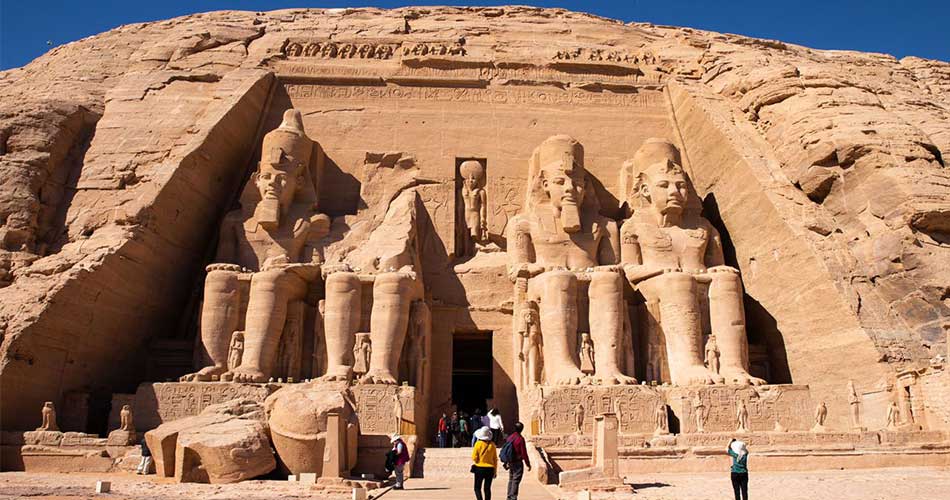Abu Simbel is an archaeological site
Abu Simbel located in southern Egypt near the Sudanese border.
The site is home to two massive rock temples that were built during the reign of Pharaoh Ramses II in the 13th century BCE. The temples are dedicated to the gods Amun, Ra-Horakhty, and Ptah and are among the most impressive examples of ancient Egyptian architecture and art.
The Abu Simbel temples are renowned for their impressive size and intricate design. The temples were carved out of solid rock and feature massive statues of the pharaoh and various gods and goddesses. The temples are also adorned with intricate carvings and hieroglyphics that depict scenes from the pharaoh’s life and the various religious ceremonies and offerings that were performed in the temples.
One of the most remarkable features of the Abu Simbel temples is their stunning location. The temples are situated on the banks of the Nile River and are surrounded by a beautiful desert landscape. The temples were originally located in a remote and inaccessible area, which helped to protect them from looting and damage over the centuries.
Despite their impressive size and beauty, the Abu Simbel temples faced numerous challenges over the centuries. The temples were damaged by earthquakes, floods, and other natural disasters, and they were also subjected to looting and vandalism by various conquerors and invaders. In the 20th century, the temples were threatened with flooding due to the construction of the Aswan High Dam, which would have submerged the entiresite underwater. In response to this threat, a massive international effort was launched to relocate the temples to higher ground.
In one of the most remarkable engineering feats of the 20th century, the temples were dismantled and moved to a new location over 200 meters away from their original site. The relocation project took several years to complete and involved cutting the temples into massive blocks, transporting them to their new location, and reassembling them piece by piece. The relocation of the Abu Simbel temples is considered to be one of the greatest achievements of modern archaeology and engineering.
Today, the Abu Simbel temples are a popular tourist destination and a significant cultural site in Egypt. Visitors can explore the various structures and admire the impressive architecture and engineering that went into building the temples. The temples also offer a glimpse into the religious beliefs and practices of the ancient Egyptians and their relationship with their pharaohs and gods.
The Abu Simbel temples are a remarkable testament to the ingenuity and skill of ancient Egyptian architects and builders. Their impressive size, intricate design, and stunning location continue to captivate and inspire visitors from around the world, and their relocation to higher ground is a testament to the enduring legacy of human ingenuity and determination.
The Abu Simbel temples are a must-see destination for anyone interested in the history and culture of ancient Egypt, and they remain one of the most awe-inspiring and impressive structures ever built by human hands. Their significance as a cultural and religious symbolof ancient Egypt cannot be overstated, and their enduring legacy underscores the importance of preserving and celebrating our shared human heritage. Despite the challenges they have faced, the Abu Simbel temples continue to inspire awe and wonder in all who visit them, and they stand as a testament to the power and majesty of one of the world’s greatest civilizations.
Abu Simble is about 150 million away from Aswan, in the southern region of Nubia near the Sudanese border . Here stands the Great Temple of Ramses ll, which represents185 fee one of the biggest accomplishments of Pharaoh Ramses ll. Ramses ll built this temple to demonstrate his power and divine nature.
The temple faces east at a very prices angle. Just twice a year in the early morning, the sun slowly creeps 185 feet into the cavernous temple through its large chambers and narrow halls and illuminates its inner sanctum. This scientific phenomenon occurs on February 22 and October 22, the dates of Ramses ll’s birthday and coronation, respectively. For only a few hours, the back wall of the innermost shrine is illuminated, mystically lighting up the three statues of Ramses ll, and the sun gods Rehorakhte and Amon Re. The fourth god represented there, the Theban god of darkness,Ptah,remains in the shadows all year.
The mammoth temple is an astounding 100 feet high, 119 feet wide, and 185 feet deep, and is carved out of solid limestone. Four enormous seated statues of the Pharaoh dominate its facade, each 67 feet high. The temple was said to radiate power, subjecting all who entered Egypt to its supremacy.
The Temple fell out use when Christianity was instituted in Egypt. It was rediscovered in 1813, when Swiss explorer Burckhard found it abandoned and filled with sand. In the sixties, when the Nile was dammed, Lake Nasser almost summersed the Temple. UNESCO came to its rescue, breaking it into pieces and moving it back 660 feet and up 231 feet. Below the seat of one of the colossal statues of Ramses ll is a sunken relief of the god Hapy, the personification of the Nile flood. The figure of Hapy appears twice, tying stems of plants around the hieroglyphic for “unite”.
On the left he holds stems of the lotus (symbol of upper Egypt) , on the right he holds stems of the papyrus (Lower Egypt). He exhibits both male and female characteristics, suggesting the fertility of the land resulting from the Nile flood. The relief illustrates the Egyptians’ concern for balance and order. Ramses ll also built the Small Temple of Hathor and Nefertari at Abu Simbel, both to honor Hathor as the goddess of love and music, as well as his favorite wife, Nefertari, as the deified queen. The facade has six standing statues over 30 feet high of Ramses and Nefertari. These statues in turn flanked by smaller statues of their children.



